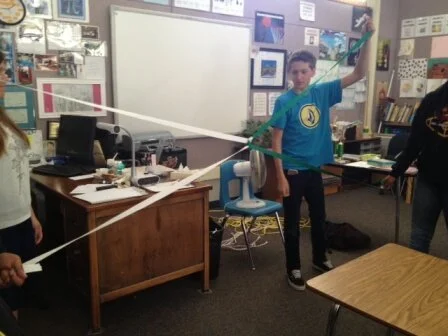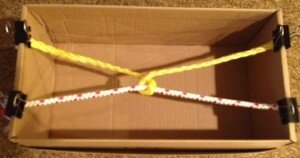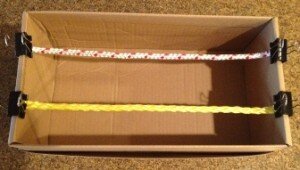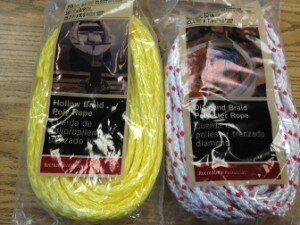Students Embroiled in Conway's Rational Tangles
Me: We're going to do an activity today.
Jonathan: Let me guess. It's your favorite activity.
M: How did you know that?
J: You say that about everything we do.
M: You have a problem with that?
J: No. But I've lost track of how many favorites you have.
M: And I've lost track of how many times you've talked without permission.
M: But I still love you though.
J: I love you too, Mrs. Win.
Yeah, so that was the exchange we had at the start of Algebra. Kids are used to me telling them how much I love them because I really do. It's the Monday-through-Friday kind of love that lasts from 8:25 am to 2:50 pm — at which time I say to them, "Get out of my room." They laugh at this; they must think I'm kidding.
Tom Davis did John Conway's Rational Tangles with us at last summer's Math Teachers' Circle (MTC). Reading this post (with lots of solid links) over the weekend reminded me of this fun lesson.
I haven't come across a written lesson of this done with school children though. So, here I am. It's my new favorite lesson.
Day 1
I use the two ropes given to us from the MTC training.
I ask for 4 student volunteers to come up front. The rest of the class needs to pay careful attention and record in their math journals what I record.
Important
The two ropes can be of the same color. Two colors are used in practice so it's easier for students to follow along.
The 4 people holding the robes can be identical quadruplets — who they are doesn't matter, but I'm referring to them as colored dots if and only if they move or change position.
The letters A, B, C, and D refer to the 4 positions, like goalposts, therefore they do not change.
The starting position is when the two ropes are horizontally parallel, and this state has a value of 0.
There are only TWO "moves" in this game of rational tangling and untangling.
A TWIST is when people in positions A and C switch places. Green moves underneath red's rope.
This move equals plus 1, meaning our ropes went from a value of 0 to a value of 1.
The only other move is called ROTATE. A rotate is when the 4 people move in a clockwise direction, each person taking the space previously occupied by the person to his/her left.
Now, the money question to the kids: What does the operation "rotate" do to the value of the ropes?
We know a twist = +1, but a rotate = ??
So, in the diagram just above, our ropes went from a value of 0 to what value?
The kids want to do a twist after this rotate, but they realize that the ropes are now funny — or vertically parallel — that you can't do a twist since there's no rope for yellow to go under, and green and yellow switching places does not change how the ropes look.
Because a twist can't be done, our only other choice is to rotate — which leads us to this configuration.
AHA! This brings us back to 0 because the ropes are horizontally parallel again.
Symbolically, we can record what happens with 2 rotates (R), done back to back, when we start with 0: 0 (R) -> ? (R) -> 0.
We need to test this again, so let's start at 0. Do 1 twist (T), then 2 rotates. This means the value goes from 0 to +1, then to some unknown value after the first rotate, but after the second rotate, the ropes have a value of +1 again.
0 (T) -> 1 (R) -> ? (R) -> 1
Someone suggests that the rotate operation means multiply by -1. This is a lovely suggestion as it seems to work: a twist of 0 makes it +1, then if a rotate means multiply by -1, then we have -1, then another rotate makes it +1 again.
Then we try to do 2 twists from 0, giving us +2. So if we do a rotate now, our value should be -2. This means we can then do 2 twists to add 2, bringing us back to 0. But it did not work!
We do a few more test moves. Someone suggests a rotate subtracts 2. Others suggest that it throws a negative sign on the value somehow, somewhere. The kids are struggling. One claims a massive headache from all this, to which I say, "Enjoy that, honey."
We have a few conjectures though:
Starting from 0 and doing 1 rotate puts our ropes in a weird (undefined?) state where we can't do a twist after that.
Two rotates, back to back, bring the ropes back to the same state prior to the first rotate. Therefore, we should not do 2 consecutive rotates unless we just want to waste time.
A rotate must involve a negative — how else can we get back to 0 by twisting alone?
I instruct the 4 volunteers through this entire sequence of moves below. The class and I record each step. As soon as we put in a rotate, however, and not know exactly what this move does to the value, we just have to put question marks in all these spaces.
I can't take pictures of the kids doing this while also teaching them, so I've re-created this at home with a shoe box and 4 well-behaved binder clips that act has the rope holders.
Step 1: Start at 0.
Step 2: Do 1 twist. Value now is 1.
Step 3: Another twist. Value = 2.
Step 4: Another twist. Value = 3.
Step 5: Rotate. Value = ??
Step 6: Twist. Value = ??
Step 7: Rotate. Value = ??
Steps 8 & 9: Twist and twist again. Value = ??
Step 10: Rotate. Value = ??
Step 11: Twist. Value = ??
Step 12: Twist. Value = 0
Kids realize that if the last two twists got the ropes back to 0, then Step 10 must have a value of -2, and Step 11 is -1.
After about 20 minutes of doing the dance with the ropes and agonizing, a couple of geometry kids figured out what a rotate does to the value of the ropes. Algebra kids did not have enough time, so they'll continue their investigation on Day 2. Because I only see my 6th graders one period a day (instead of 2 periods/day for algebra and geometry) and they being younger, I told them what "rotate" does mathematically. There will still be plenty of math for them to do on Day 2.
Day 2
It's more fun when the kids can participate instead of just watching the 4 kids in front of the room. I go to Lowe's to pick up the ropes for about $12.
Kids will be in groups of five, four are holding the ropes and doing the moves, one person records and oversees that everyone in group is moving appropriately. Each group gets 2 ropes, one of each color, and each rope is about 7 feet long.
All the groups will first follow the same set of crazy tangle moves that I give them. Something like, "Start at 0, twist 4 times, rotate, twist 2 times, rotate, twist 3 times, rotate, twist 5 times. Okay, now figure out how to get back to 0."
(Algebra kids still need to figure out what a rotate does to the value of the ropes before they break out into groups.)
When they figure out my tangle, I'll have each team create their own tangle and undo the mess. Of course they'll have to record all the moves from 0 and back to 0 symbolically.
How will your kids figure out what the "rotate" operation does?
Update 03/13/12
As planned, I had the kids in groups of 5 and made this tangle: Start at 0, twist 3 times, rotate, twist twice, rotate, twist 5 times. Then they had to untangle this and get back to 0.
How the kids persevered through this entire problem was really amazing.
They hugged each other and jumped for joy when they untangled the ropes. Especially touching was the group that was the last to solve the problem — wish I'd captured it on camera/video.
This group was first to find the solution. (They had to create one of their own after this.)
If above video is not enough to convince you to do this with your kids, here's a tweet from Sam this morning. Imagine that — this activity blew young Sam's brilliant mind.


















